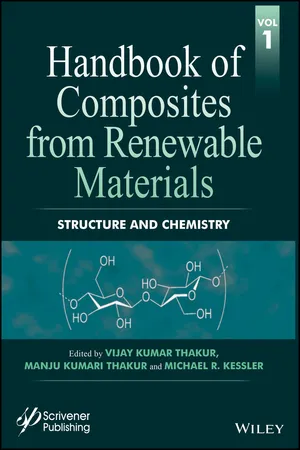
Handbook of Composites from Renewable Materials, Structure and Chemistry
- English
- ePUB (mobile friendly)
- Available on iOS & Android
Handbook of Composites from Renewable Materials, Structure and Chemistry
About this book
This unique multidisciplinary 8-volume set focuses on the emerging issues concerning synthesis, characterization, design, manufacturing and various other aspects of composite materials from renewable materials and provides a shared platform for both researcher and industry.
The Handbook of Composites from Renewable Materials comprises a set of 8 individual volumes that brings an interdisciplinary perspective to accomplish a more detailed understanding of the interplay between the synthesis, structure, characterization, processing, applications and performance of these advanced materials. The Handbook comprises 169 chapters from world renowned experts covering a multitude of natural polymers/ reinforcement/ fillers and biodegradable materials.
Volume 1 is solely focused on the Structure and Chemistry of renewable materials. Some of the important topics include but not limited to: carbon fibers from sustainable resources; polylactic acid composites and composite foams based on natural fibres; composites materials from other than cellulosic resources; microcrystalline cellulose and related polymer composites; tannin-based foam; renewable feedstock vanillin derived polymer and composites; silk biocomposites; bioderived adhesives and matrix polymers; biomass-based formaldehyde-free bioresin; isolation and characterization of water soluble polysaccharide; biobased fillers; keratin-based materials in biotechnology; structure of proteins adsorbed onto bioactive glasses for sustainable composite; effect of filler properties on the antioxidant response of starch composites; composite of chitosan and its derivate; magnetic biochar from discarded agricultural biomass; biodegradable polymers for protein and peptide conjugation; polyurethanes and polyurethane composites from biobased / recycled components.
Frequently asked questions
- Essential is ideal for learners and professionals who enjoy exploring a wide range of subjects. Access the Essential Library with 800,000+ trusted titles and best-sellers across business, personal growth, and the humanities. Includes unlimited reading time and Standard Read Aloud voice.
- Complete: Perfect for advanced learners and researchers needing full, unrestricted access. Unlock 1.4M+ books across hundreds of subjects, including academic and specialized titles. The Complete Plan also includes advanced features like Premium Read Aloud and Research Assistant.
Please note we cannot support devices running on iOS 13 and Android 7 or earlier. Learn more about using the app.
Information
Chapter 1
Carbon Fibers from Sustainable Resources
Abstract
1.1 Introduction
- Technical standpoint: Chemical composition of the precursor is vital; it should present a high carbon content, at least 92 wt% of anisotropic carbon (Frank et al., 2014). Also, it should not melt during carbonization (Park & Heo, 2015).
- Economic standpoint: Compared with other artificial fibers (e.g., glass and polymeric fibers), CF are costly, which limits their use to a range of applications (Wu et al., 2013). Moreover, as reported by Mainka et al., (2015), more than 50% of the carbon fiber cost is related to the precursor, 15% to the oxidation process and 23% to the carbonization process. The price of the precursor is linked to its availability, as is its isolation process.
- Environmental standpoint: Preferably, processing should not result in toxic wastes, and the precursor should come from a sustainable resource.
1.2 Lignin and Other Sustainable Resources
Table of contents
- Cover
- Title page
- Copyright page
- Dedication
- Preface
- Chapter 1: Carbon Fibers from Sustainable Resources
- Chapter 2: Polylactic Acid Composites and Composite Foams Based on Natural Fibers
- Chapter 3: Microcrystalline Cellulose and Related Polymer Composites: Synthesis, Characterization and Properties
- Chapter 4: Tannin-Based Foams: The Innovative Material for Insulation Purposes
- Chapter 5: Renewable Feedstock Vanillin-Derived Polymer and Composites: Structure Property Relationship
- Chapter 6: Biomass-Based Formaldehyde-Free Bio-Resin for Wood Panel Process
- Chapter 7: Bio-Derived Adhesives and Matrix Polymers for Composites
- Chapter 8: Silk Biocomposites: Structure and Chemistry
- Chapter 9: Isolation and Characterisation of Water Soluble Polysaccharide from Colocasia esculenta Tubers
- Chapter 10: Bio-Based Fillers for Environmentally Friendly Composites
- Chapter 11: Keratin-Based Materials in Biotechnology
- Chapter 12: Pineapple Leaf Fiber: A High Potential Reinforcement for Green Rubber and Plastic Composites
- Chapter 13: Insights into the Structure of Proteins Adsorbed onto Bioactive Glasses
- Chapter 14: Effect of Filler Properties on the Antioxidant Response of Thermoplastic Starch Composites
- Chapter 15: Preparation and Application of the Composite from Chitosan
- Chapter 16: Overview on Synthesis of Magnetic Bio Char from Discarded Agricultural Biomass
- Chapter 17: Polyurethanes Foams from Bio-Based and Recycled Components
- Chapter 18: Biodegradable Polymers for Protein and Peptide Therapeutics: Next Generation Delivery Systems
- Index
- End User License Agreement